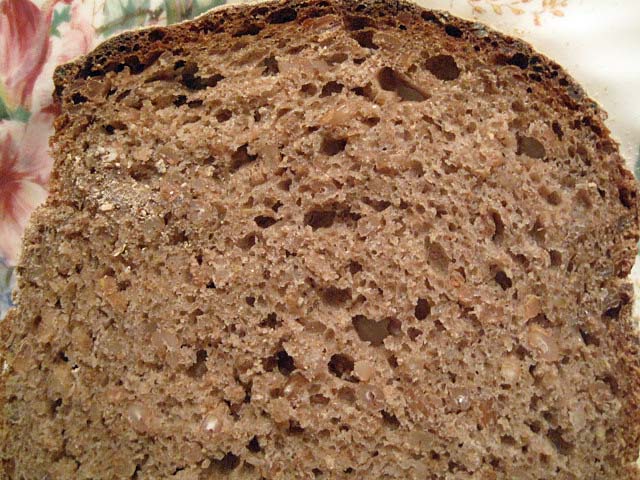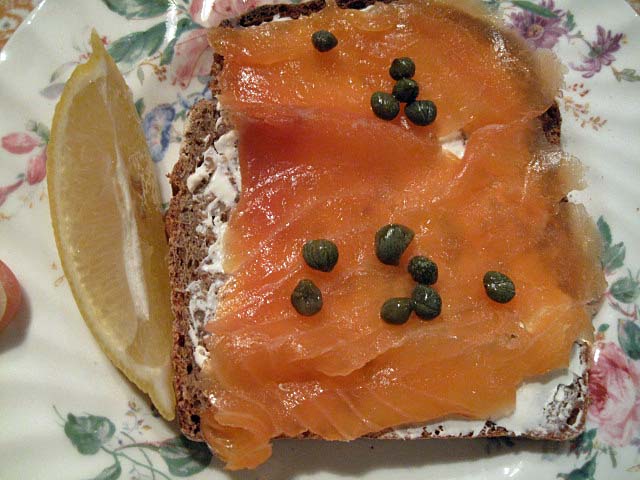Almost all the breads I bake are hearth loaves, but I've been tempted for some time to make one of the German-style ryes that Hamelman says should be baked in a pullman pan (AKA pain de mie pan).

Pullman or pain de mie pan
I purchased a pullman pan from KAF's Baker's Catalogue. It is from the new line of bakeware they are carrying, and it is a beautiful piece of metal. But this is not a review of baking pans, so back to bread …
Today, I baked the “70 Percent Rye with a Rye Soaker and Whole Wheat Flour” from Hamelman's Bread. It is made with medium rye, all pre-fermented. The rye soaker is in the form of rye chops – an equal weight to that of the medium rye. The remaining 30% of the flour weight consists of whole wheat flour. The dough is 78% hydration and has 2% salt and ¼ tsp of instant yeast.
Not having rye chops at hand, I hand-chopped the 390 g of rye berries needed for making 2 kg of dough, which is what is needed to fill my 13” pullman pan. (Did I tell you how beautiful it is?) Now, I believe that Andy (or was it MiniO?) claims the proper way to make rye chops by hand is to slice each berry into 3 equal pieces. I didn't do that. After trying to chop the berries on a cutting board with a chef's knife, which sent berries – whole and in fragments of varying sizes and shapes – flying everywhere, I turned to the chopping method I learned at my mother's knee. She never chopped rye berries, I'm sure, but she sure chopped a lot of fish for gefilte fish in the years before the coming of the Cuisinart. I still have her chopping bowl and hackmesser. (I believe that's what she called it.)

Well, I made a lot of little pieces of rye, but I figure I ended up with a mix of coarse rye flour, cracked rye, rye chops and whole (and very smug) rye berries. So, I poured boiling water over the whole mess and ordered a grain mill.
This morning my rye sour was ripe and smelling wonderfully sour and fruity. My soaker was soaked. I mixed the dough.
Now this is a 70% rye, since the cracked rye is included as a flour in calculating baker's percentages. But, really, if you look at the flour, it's about 50% rye and 50% whole wheat. I've made several other 70 and 80% ryes before, and this was different. There was much less gluten development with mixing. I've not yet made a 100% rye, but I imagine it's not much different from this dough. Maybe it was the whole wheat flour, whereas the other ryes I'd made used high-protein white flours. This dough was completely like sticky clay. But not insurmountable.
I mixed the dough in my KitchenAid – about 2 minutes at Speed 1 and 6 minutes at Speed 2. Then, the dough was fermented for 60 minutes. (Hamelman says ferment for 30 minutes, but my kitchen was only about 67ºF today.) I formed the dough into a log and placed it in the pullman pan which had been lightly oiled and dusted with pumpernickel flour. After 60 minutes proofing with only a little expansion of the dough, the loaf was baked with steam for 15 minutes at 480ºF, then for another 60 minutes in a dry oven at 415ºF. The last 15 minutes of the bake was with the loaf out of the pan, on a baking sheet, to dry the sides of the loaf. There was really nice oven spring. The loaf crested well above the top of the pan. (Sorry, I neglected to photograph the baked loaf still in the pan.) In hindsight, I probably should have proofed more fully. There was some bursting of the loaf on one side, at the point it expanded over the top of the pan.

Rye dough in pan, sprinkled with pumpernickel flour and ready to proof

Rye bread cooling
After cooling, I wrapped the loaf in baker's linen, as instructed.

Rye wrapped in linen
The loaf was wrapped in baker's linen for 24 hours before slicing ... and tasting.

Pre-slicing (Big bread, isn't it?)

Coronal section with crumb

Crumb, close-up

Another close-up

Delicious plain. More delicious with smoked salmon!
The crust was firm but not hard. The crumb was soft and moist but slightly crumbly and less dense than I expected. The aroma is powerful with rye, yet the flavor is relatively mild. It is rye with no distinctive whole wheat tones, yet the whole wheat must have mellowed the rye flavor. There is a sweet note to the aftertaste. The rye "chops" are very chewy, which I like.
This bread has lots of character, and I enjoyed it unadorned. I had another slice with a thin schmear of cream cheese and a thin slice of Scottish smoked salmon, with some capers and drops of lemon juice. Fantastic!
David